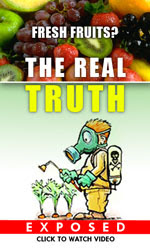 John Summerly, Prevent Disease
John Summerly, Prevent Disease
Waking Times
Practiced for thousands of years by cultures around the world –detoxification is about resting, cleansing and nourishing the body from the inside out. By removing and eliminating toxins, then feeding your body with healthy nutrients, detoxifying can help protect you from disease and renew your ability to maintain optimum health. These foods will assist in boosting your metabolism, optimizing digestion, while allowing you to lose weight and fortify your immune system.
1. ARTICHOKES
Artichokes help the liver function at its best, which in turn will help your body purge itself of toxins and other things it doesn't need to survive. It ups the liver's production of bile, and since bile helps break down foods which helps your body use the nutrients inside them, an increase in bile production is typically a good thing.
2. APPLES
Apples are full of wonderful nutrients. You get fibre, vitamins, minerals and many beneficial phytochemicals such as D-Glucarate, flavonoids and terpenoids. All of these substances are used in the detox process. One flavonoid, Phlorizidin (phlorizin), is thought to help stimulate bile production which helps with detox as the liver gets rid of some toxins through the bile. Apples are also a good source of the soluble fibre pectin, which can help detox metals and food additives from your body. It's best to eat only organic apples as the non-organic varieties are among the top 12 foods that have been found to contain the most pesticide residues. Organically produced apples also have a 15 percent higher antioxidant capacity than conventionally produced apples.
3. ALMONDS
Almonds are the best nut source of Vitamin E. In fact, just one ounce contains 7.3 mg of "alpha-tocopherol" vitamin E, the form of the vitamin the body prefers. They're also high in fiber, calcium, magnesium, and useable protein that helps stabilize blood sugar and remove impurities from the bowels.
4. ASPARAGUS
Not only does asparagus help to detoxify the body, it can help you wage the anti-aging battle, protect you from getting cancer, help your heart to stay healthy, and is a general anti-inflammatory food. It's also known to help with liver drainage, which might sound like a bad thing, but since the liver is responsible for filtering out the toxic materials in the food and drinks we consume, anything that backs up its drainage is not doing you any favors. Asparagus also helps reduce risk of death from breast cancer and increase the odds of survival.
5. AVOCADOS
 This wonder fruit is packed with antioxidants, lowers cholesterol and dilates the blood vessels while blocking artery-destroying toxicity. Avocados contain a nutrient called glutathione, which blocks at least 30 different carcinogens while helping the liver detoxify synthetic chemicals. Researchers at the University of Michigan found that elderly people who had high levels of glutathione were healthier and less likely to suffer from arthritis. Consuming avocados is associated with better diet quality and nutrient intake level, lower intake of added sugars, lower body weight, BMI and waist circumferences, higher "good cholesterol" levels and lower metabolic syndrome risk.
This wonder fruit is packed with antioxidants, lowers cholesterol and dilates the blood vessels while blocking artery-destroying toxicity. Avocados contain a nutrient called glutathione, which blocks at least 30 different carcinogens while helping the liver detoxify synthetic chemicals. Researchers at the University of Michigan found that elderly people who had high levels of glutathione were healthier and less likely to suffer from arthritis. Consuming avocados is associated with better diet quality and nutrient intake level, lower intake of added sugars, lower body weight, BMI and waist circumferences, higher "good cholesterol" levels and lower metabolic syndrome risk.
6. BASIL
Basil has anti-bacterial properties, and it's full of antioxidants to protect the liver. The active ingredients are terpenoids. It is also wonderful for digestion and detoxification, too. It supports the functioning of the kidneys and also acts as a diuretic to help the body expel unwanted toxins. Basil has been known to have anti-ulcer qualities as well as antimicrobial effects that guard against bacteria, yeast, fungi and mold. Basil seed can also help with constipation. The anticancer properties of basil may also relate to its ability to influence viral infections.
7. BEETS
A single serving of beets can do more for your health than most foods in the produce isle. Not only can they boost your energy and lower your blood pressure, but eating beets in the long-term can help you fight cancer, reduce arthritic pain, boost your brain as well as help you lose weight. Beets contain a unique mixture of natural plant chemicals (phytochemicals) and minerals that make them superb fighters of infection, blood purifiers, and liver cleansers. They also help boost the body's cellular intake of oxygen, making beets excellent overall body cleansers. When you're detoxing, beets will help by making sure that the toxins you're getting out actually make it out of your body. Many detox cleanses go wrong when toxins are reintroduced to the body because they don't make it all the way out.
8. BLUEBERRIES
Blueberries contain natural aspirin that helps lessen the tissue-damaging effects of chronic inflammation, while lessening pain. Just 300 grams of blueberries protects against DNA damage. Blueberries also act as antibiotics by blocking bacteria in the urinary tract, thereby helping to prevent infections. They have antiviral properties and are loaded with super-detoxifying phytonutrients called proanthocyanidins.
9. BRAZIL NUTS
These tasty treats are packed with selenium, which is key to flushing mercury out of your body. The body uses selenium to make 'selenoproteins', which work like antioxidants preventing damage to cells and there is growing body of evidence to show it has a key role in our health. The consumption of brazil nuts has been found to be inversely associated with risk of pancreatic cancer, independent of other potential risk factors for pancreatic cancer.
10. BROCCOLI
Broccoli specifically works with the enzymes in your liver to turn toxins into something your body can eliminate easily. If you're stuck for ways on how to make broccoli taste better try dehydrating or consider eating it raw. But don't microwave it as this destroys both the nutritional and detox potential. Broccoli contains a very powerful anti-cancer, anti-diabetic and anti-microbial called sulforaphane which helps prevent cancer, diabetes, osteoporosis and allergies.
11. BROCCOLI SPROUTS
 Broccoli sprouts can actually provide more benefit than regular broccoli as they contain 20 times more sulfurophane. They contain important phytochemicals that are released when they're chopped, chewed, fermented, or digested. The substances are released then break down into sulfurophanes, indole-3-carbinol and D-glucarate, which all have a specific effect on detoxification. Add these to your salads and get creative with them in your meals. Researchers have found that an oral preparation made from broccoli sprouts trigger an increase in inflammation-fighting enzymes in the upper airways.
Broccoli sprouts can actually provide more benefit than regular broccoli as they contain 20 times more sulfurophane. They contain important phytochemicals that are released when they're chopped, chewed, fermented, or digested. The substances are released then break down into sulfurophanes, indole-3-carbinol and D-glucarate, which all have a specific effect on detoxification. Add these to your salads and get creative with them in your meals. Researchers have found that an oral preparation made from broccoli sprouts trigger an increase in inflammation-fighting enzymes in the upper airways.
12. CABBAGE
In addition to cleansing your liver, cabbage will also aid in helping you go to the bathroom, which in turn helps you expel the toxins, getting them out of your system so you can start fresh. It contains sulfur, which is essential when it comes to breaking down chemicals and removing them from your body. Along with other cole crops, cabbage is a source ofindole-3-carbinol, a chemical that boosts DNA repair in cells and appears to block the growth of cancer cells.
13. CILANTRO
Cilantro, also known as coriander, Chinese parsley or dhania, contains anabundance of antioxidants. Cilantro helps mobilize mercury and other metals out of the tissue so it can attach to it other compounds and allow it to be excreted from the body. It also contains an antibacterial compound called dodecenal, which laboratory tests showed is twice as effective as the commonly used antibiotic drug gentamicin at killing Salmonella.
14. CINNAMON
The oils from cinnamon contain active components called cinnamaldehyde, cinnamyl acetate, and cinnamyl alcohol. Cinnamaldehyde has been well-researched for its effects on blood platelets helps prevent unwanted clumping of blood cells. Cinnamon's essential oils also qualify it as an "anti-microbial" food, and cinnamon has been studied for its ability to help stop the growth of bacteria as well as fungi, including the commonly problematic yeast Candida. Cinnamon's antimicrobial properties are so effective that recent research demonstrates this spice can be used as an alternative to traditional food preservatives. It has one of the highest antioxidant values of all foodsand its use in medicine treats everything from nausea to menstruation and energy to diabetes.
15. CRANBERRIES
While they are more popular as fruits that help prevent urinary tract infections, cranberries are antibacterial and are known to remove many different toxins from your body. Cranberries feature a rich profile of anti-inflammatory nutrients, provide immune and cardiovascular support, as well as promote digestive health. Consuming cranberry products has beenassociated with prevention of urinary tract infections (UTIs) for over 100 years.
16. DANDELIONS
Dandelions are considered a powerhouse food full of nutrients that are essential for anyone regularly eating processed foods. Dandelion root (taraxacum officinale) is known to act on the liver and pancreas bystraining and filtering toxins & wastes from the bloodstream and its beneficial effects on liver complaints have been well documented by both Asian practitioners and American physicians. They're a rich source of minerals and provide a variety of phytonutrients. They're super antioxidants that support cleansing of the digestive tract. Try adding dandelion leaves to your salad.
17. FENNEL
The fennel bulb is high in fiber may also be useful in preventing colon cancer. In addition to its fiber, fennel is a very good source of folate, a B vitamin that is necessary for the conversion of a dangerous molecule called homocysteine into other, benign molecules. The vitamin C found in fennel bulb is directly antimicrobial and is also needed for the proper function of the immune system.
18. FLAXSEEDS
When detoxifying your body, it's essential to ensure toxins are eliminated properly. Ground flaxseeds provide a wonderful source of fibre that helps to bind and flush toxins from the intestinal tract. They're also a great source of health promoting omega 3 oils. Try consuming two tablespoons of ground flaxseeds in lemon water every morning. University of Copenhagen researchers report that flax fiber suppresses appetite and helps support weight loss. Men should be cautious when consuming flax as the lignans are similar to the female hormone estrogen as can cause problems for some men.
19. GARLIC
Many detox diets list garlic as a crucial piece of the puzzle. The reason is that garlic boosts the immune system as well as helping out the liver. One good thing about garlic is that you can up your intake without having to worry if your body is going to get used to it or build up a resistance.Sulfur is found in high quantities in garlic — which makes it a good detox food and its antibiotic properties heal your body. Garlic is proven to be 100 times more effective than antibiotics and working in a fraction of the time.
20. GINGER
 Along side turmeric, ginger is one of the world's most potent disease-fighting spices. Ginger spikes your metabolism, flushes out waste, is thought to help liver function, and has some astringent properties. Some detox diets ask you to chew on ginger root. You may also find that adding it to hot water makes the water taste better. Basically any way you can think of it get it into your system is going to be beneficial, especially if you're suffering from a fatty liver caused by too much alcohol, or too many toxic foods and drinks.
Along side turmeric, ginger is one of the world's most potent disease-fighting spices. Ginger spikes your metabolism, flushes out waste, is thought to help liver function, and has some astringent properties. Some detox diets ask you to chew on ginger root. You may also find that adding it to hot water makes the water taste better. Basically any way you can think of it get it into your system is going to be beneficial, especially if you're suffering from a fatty liver caused by too much alcohol, or too many toxic foods and drinks.
21. GOJI BERRIES
Replace raisins with nutrient-dense Goji berries to boost your vitamin C and beta-carotene intake. Gram for gram, goji berries pack more vitamin C than oranges and more beta-carotene than carrots. Vitamin C can help remove waste from your body, while beta-carotene improves liver performance.
22. GRAPEFRUIT
Grapefruits can prevent weight gain, treat diabetes, lower cholesterol, fight cancer, heal stomach ulcers, reduce gum disease and even keep stroke and metabolic syndrome at bay. Grapefruits can treat disease as well as pharmaceuticals without the side effects. The rich pink and red colors of grapefruit are due to lycopene, a carotenoid phytonutrient. Among the common dietary carotenoids, lycopene has the highest capacity to help fight oxygen free radicals, which are compounds that can damage cells. The big takeaway on grapefruit is that it gets your liver fired up and ready for action, while infusing the rest of your organs with nutrient-laden fruit juice.
23. GREEN TEA
Green tea is often thought of as a great addition to any detox program because of its high antioxidant value. It is the least processed tea and thus provides the most antioxidant polyphenols, notably a catechin called epigallocatechin-3-gallate (EGCG), which is believed to be responsible for most of the health benefits linked to green tea. According to 17 clinical trials, green tea is linked with significantly lower blood sugar.
24. HEMP
Hemp might just be one of nature's most perfect foods since it is full of antioxidants like Vitamins E and C, as well as chlorophyll which is wonderful for cleansing the body from toxins of all kinds, including heavy metals. The soluble and insoluble fiber in hemp can also keep the digestive tract clean and therefore, reduce the toxic burden on other internal organs. Hemp could free us from oil, prevent deforestation, cure cancer and it's environmentally friendly.
25. KALE
Kale is now recognized as providing comprehensive support for the body's detoxification system. New research has shown that the ITCs made from kale's glucosinolates can help regulate detox at a genetic level. This vegetable is so good for you that it is often recommended to patients that are following a doctor recommended diet when fighting kidney disease. It's packed with so many antioxidants and has anti-inflammatory properties as well, not to mention all of the vitamins and minerals it contains. Leafy greens are likely the number one food you can eat to regularly help improve your health. They're filled with fiber along with crucial vitamins, minerals, and plant-based phytochemicals that may help protect you from almost every disease known.
26. LEMONGRASS
This is an herb that is used in Thailand and other parts of the world as a natural way to cleanse several organs at once. It not only helps the liver but also the kidneys, the bladder, and the entire digestive tract. Benefits of using it in your cooking, or drinking it as a tea include a better complexion, better circulation, and better digestion. It is most often used as a tea in the world of detoxing, and there are several recipes you can try until you find one that suits your tastes best.
27. LEMONS
This wonderful fruit stimulates the release of enzymes and helps convert toxins into a water-soluble form that can be easily excreted from the body. In addition, they contain high amounts of vitamin C, a vitamin needed by the body to make glutathione. Glutathione helps ensure that phase 2 liver detoxification keeps pace with phase 1, thereby reducing the likelihood of negative effects from environmental chemicals. Drinking lemon water, which is alkaline-forming, first thing in the morning will help to balance out the acidity of foods we've consumed. They also have an incredible effect in detoxing the liver. Fresh lemon juice contains more than 20 anti-cancer compounds and helps balance the body's pH levels. Here are 45 uses for lemons that will blow your socks off.
28. OLIVE OIL
Some liver cleanses out there call for olive oil mixed with fruit juice in order to trigger your liver to expunge its gallstones. But aside from that olive oil should be your go-to oil when you're trying to detox the body. That's because it has a lot of healthy properties, and makes for a better choice of fat than most of your other options. Just be sure not to cook with it at high heat. Use it as a salad dress to help things like dark leafy greens go down. Your best choice is always ice-pressed olive oil, but if you can find a very high quality cold-pressed olive oil, although not as nutritious, it will suffice provided the quality is high and not adulterated.
29. ONIONS
This ubiquitous kitchen staple is as healthy as it is tasty. It's brimming with sulfur-containing amino acids, which efficiently detox the liver. Raw onions deliver the most health benefits. Even a small amount of "overpeeling" can result in unwanted loss of flavonoids. For example, a red onion can lose about 20% of its quercetin and almost 75% of its anthocyanins if it is "overpeeled". Onions will soak up arsenic, cadmium, lead, mercury and tin in contaminated foods. The total polyphenol content of onion is not only higher than its fellow allium vegetables, garlic and leeks, but also higher than tomatoes, carrots, and red bell pepper. Onions have been shown to inhibit the activity of macrophages, specialized white blood cells that play a key role in our body's immune defense system, and one of their defense activities involves the triggering of large-scale inflammatory responses.
 30. PARSLEY
30. PARSLEY
Those pretty green leaves don't just make your plate look great. Parsley boasts plenty of beta-carotene and vitamins A, C and K to protect your kidneys and bladder. Diuretic herbs such as parsley prevent problems such as kidney stones and bladder infections and keep our body's plumbing running smoothly by causing it to produce more urine. They also relieve bloating during menstruation. The flavonoids in parsley–especially luteolin–have been shown to function as antioxidants that combine with highly reactive oxygen-containing molecules (called oxygen radicals) and help prevent oxygen-based damage to cells. In addition, extracts from parsley have been used in animal studies to help increase the antioxidant capacity of the blood.
31. PINEAPPLES
This tropical delight contains bromelain, a digestive enzyme that helps cleanse your colon and improve digestion. Excessive inflammation, excessive coagulation of the blood, and certain types of tumor growth may all be reduced by bromelain. Two molecules isolated from an extract of crushed pineapple stems have even shown promise in fighting cancer growth.
32. SEAWEED
Seaweed may be the most underrated vegetable in the Western world. Studies at McGill University in Montreal showed that seaweeds bind to radioactive waste in the body so it can be removed. Radioactive waste can find its way into the body through some medical tests or through food that has been grown where water or soil is contaminated. Seaweed also binds to heavy metals to help eliminate them from the body. In addition, it is a powerhouse of minerals and trace minerals. Seaweed extracts can help you lose weight, mostly body fat.
33. SESAME SEEDS
Sesame seeds' phytosterols have beneficial effects which are so dramatic that they have been extracted from many foods and added to processed foods, such as "butter"-replacement spreads, which are then touted as cholesterol-lowering "foods." But why settle for an imitation "butter" when Mother Nature's nuts and seeds are a naturally rich source of phytosterols–and cardio-protective fiber, minerals and healthy fats as well? Sesame seeds contain minerals important in a number of antiinflammatory and antioxidant enzyme systems. Sesame representsone of the top 10 healthiest seeds on Earth.
34. TURMERIC
Curcumin is the active ingredient in the spice turmeric, which gives it its yellow color. The rate at which your detox pathways function depends on your genes, your age, lifestyle and a good supply of nutrients involved in the detox process. Curcumin is used a lot in Ayurvedic Medicine to treat liver and digestive disorders. Turmeric has specifically been studied in relation to the positive effect that it has on the liver. As a high antioxidant spice, turmeric protects the body and prevents disease more effectively than drug based treatments and without the side effects.
35. WATERCRESS
Give your liver a big boost with cleansing action of watercress. If you're into making smoothies for your detoxing this is a great one to blend up and drink down. This helps to release enzymes in the liver that clean it out and help rid it of toxic buildup. Eating watercress every day helps prevent breast cancer.
36. WHEATGRASS
Wheatgrass restores alkalinity to the blood. The juice's abundance of alkaline minerals helps reduce over-acidity in the blood and thus also Is a powerful detoxifier, and liver protector. It increases red blood-cell count and lowers blood pressure. It also cleanses the organs and gastrointestinal tract of debris. Wheatgrass stimulates the metabolism and the body's enzyme systems by enriching the blood. It also aids in reducing blood pressure by dilating the blood pathways throughout the body. Pound for pound, wheatgrass is more than twenty times denser in nutrients than other choice vegetables. Nutritionally, wheatgrass is a complete food that contains 98 of the 102 earth elements.
About the Author
John Summerly is nutritionist, herbologist, and homeopathic practitioner. He is a leader in the natural health community and consults athletes, executives and most of all parents of children on the benefits of complementary therapies for health and prevention.
Sources:
whfoods.com























